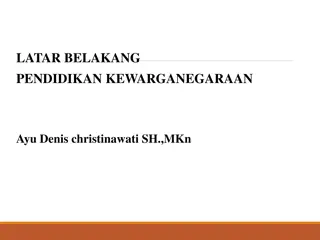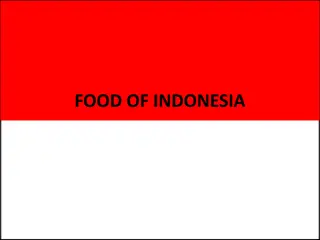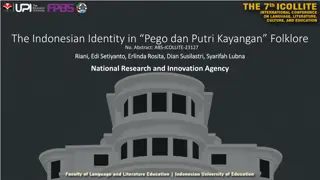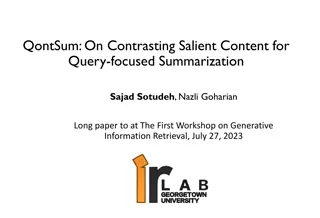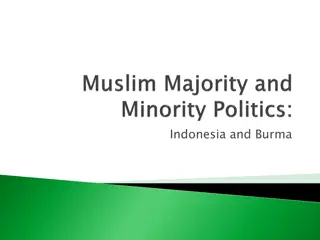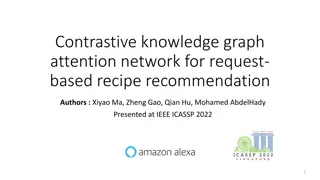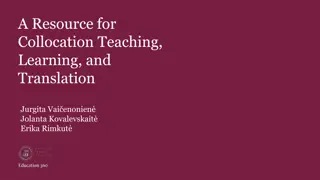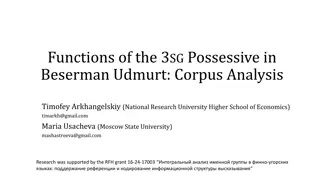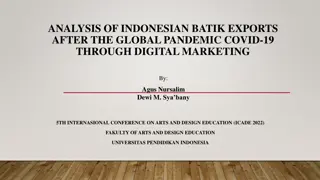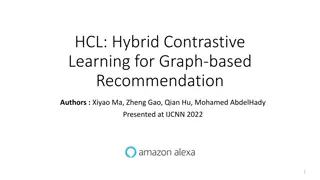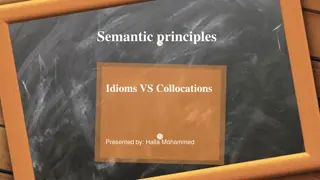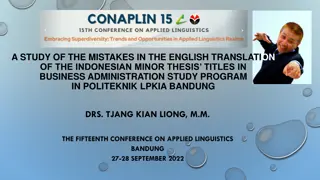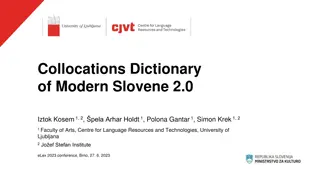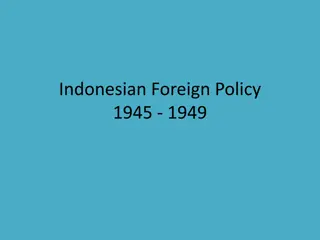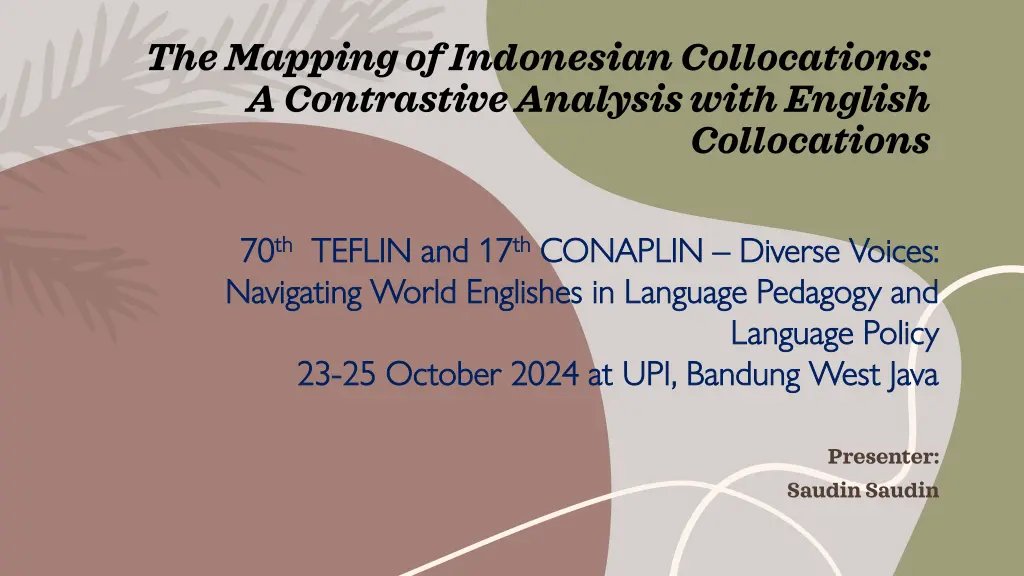
Indonesian Collocations: A Contrastive Analysis with English Collocations
Explore the significance of collocations in language fluency and proficiency, emphasizing Indonesian collocations through a contrastive analysis with English collocations. This research sheds light on the importance of including collocations in language teaching curricula and delves into the neglected realm of Indonesian collocation studies. Discover the patterns, similarities, and uniqueness of Bahasa Indonesia collocations in this in-depth analysis.
Download Presentation

Please find below an Image/Link to download the presentation.
The content on the website is provided AS IS for your information and personal use only. It may not be sold, licensed, or shared on other websites without obtaining consent from the author. If you encounter any issues during the download, it is possible that the publisher has removed the file from their server.
You are allowed to download the files provided on this website for personal or commercial use, subject to the condition that they are used lawfully. All files are the property of their respective owners.
The content on the website is provided AS IS for your information and personal use only. It may not be sold, licensed, or shared on other websites without obtaining consent from the author.
E N D
Presentation Transcript
The Mapping of Indonesian Collocations: A Contrastive Analysis with English Collocations 70 70th th TEFLIN and 17 TEFLIN and 17th th CONAPLIN Navigating World Navigating World Englishes Englishes in Language Pedagogy and CONAPLIN Diverse Voices: Diverse Voices: in Language Pedagogy and Language Policy Language Policy 25 October 2024 at UPI, Bandung West Java 23 23- -25 October 2024 at UPI, Bandung West Java Presenter: SaudinSaudin
I. INTRODUCTION II. RESEARCH PURPOSES topics III. LITERATURE REVIEW IV. METHODOLOGY V. FINDINGS VI. SUMMARY
I. Introduction 1. Collocation is a benchmark of language fluency and proficiency (Basal, 2019; Bui, 2021; Lateh et al., 2021) 2. Collocation is positively related to the 4 language skillsi.e. Listening(Hsu, 2005 in Bui, 2021), Speaking (Boers, 2006 in Estaji & Montazeri, 2022; Vaupot, 2021), Reading (Hunston & Francis, 2000 in Vaupot, 2021), and Writing (Abdi & Ariffin, 2020; Vaupot, 2021)even to translation quality/naturalness (Feng, 2020) 3. Inclusion of collocation in the language teaching curriculum is a must (Bui, 2021; Vaupot, 2021) 4. The importance of research on collocation is widely acknowledged(Srdanovic, 2014 in Lirong, 2022) 5. Research on Indonesian collocations has been neglected for years. 2024 Indonesian Collocations: A Contrastive Analysis with English Collocations 3
Contd Indonesian journals of linguistics and culture (i.e. Aksara, Dialektika, Linguistik Indonesia, Ranah, and Wacana) have not published even one research article about Bahasa Indonesia collocations in the last five years of their publications (2019-2024) Via the Google search engine, only two articles on the subject are found: 1. Imran et al. (2009) Kolokasi Bahasa Indonesia 2. Lirong (2022) Studi Bebasis Korpus: Perbandingan Kolokasi dan Prosodi Semantik Sinonim Bahasa Indonesia Menyebabkan dan Mengakibatkan 2024 Indonesian Collocations: A Contrastive Analysis with English Collocations 4
II.RESEARCH PURPOSES: 1. To map the patterns of Bahasa Indonesia collocations, divided into lexical and grammatical collocations 2. To reveal the similarities between lexical and grammatical collocations of Bahasa Indonesia and those of English 3. To show the uniqueness of Bahasa Indonesia collocations 5
III. LITERATURE REVIEW A. Definition of Collocation: (1)frequently co-occurring word combinations with a high strength of association (Garibyan et al., 2022). (2)a combination of words in a language that happens very often and more frequently than would happen by chance (Oxford Learner's Dictionaries). (3)a co-occurrence of two words or more that are semantically associative, sound natural, and shape an acceptable term or a standard language structure. 2024 Indonesian Collocations: A Contrastive Analysis with English Collocations 6
B. The Categories of Collocation Based on the word class that builds it, collocation is divided into two major categories with their own respective sub-types (Benson et al., 2009 slightly adapted as suggested by Mahvelati & Mukundan, 2012; Saudin et al., 2017) as follows: (1) LEXICAL COLLOCATION 1. Verb + Noun: make mistakes, do damage, draw a conclusion; 2. Adjective + Noun: strong wind, fast food, heavy rain; 3. Noun + Noun traffic accident, human resources, a drop of water, a flock of birds; 4. Verb + Adverb: laugh merrily, rain heavily, argue heatedly; 5. Adverb + Adjective: strikingly different, wide awake, truly mad; 6. Noun + Verb: doctors diagnose, a baby cries, a dog barks; 7. Verb + Adjective: turn grey, go blind, keep clean). 2024 Indonesian Collocations: A Contrastive Analysis with English Collocations 7
(2) Grammatical Collocation 1. Noun + Prep: attack on, error in, need for; 2. Verb + Prep: depend on, dry up, look after, turn off; 3. Verb+Obj+Prep: send a letter to, sing a song to, make a coffee for; 4. Adjective + Prep: dependent on, familiar with, close to, aware of; 5. Prep + Noun: by accident, in despair, at speed, on purpose; 6. Binomials (two words joined with a conjunction and the order is fixed, rarely reversed): safe and sound, loud and clear, dead or alive, more or less (suggested by Al-Otaibi, 2023; James, 1998 in Boonnoon, 2020); 7. Noun + To-Infinitive: trouble to digest food; 8. Adjective + To-infinitive: glad to meet you; 9. Noun + That-clause: a rumor that they got divorced; 10. Adjective + That-clause: good that you join at last. 2024 Indonesian Collocations: A Contrastive Analysis with English Collocations 8
IV. Methodology DESCRIPTIVE ANALYTICAL RESEARCH DESIGN CONTRASTIVE ANALYSIS (CA) o Mapping Bahasa Indonesia collocations against English collocations was drawn upon the theory of CA. DATA SOURCES o Main reports of a national magazine and newspaper headlines o 14,206 lexical items altogether o Documents/texts as data sources are used to describe a phenomenon. o In-depth analysis is conducted to gain complete data. o Though diverse, languages share some fundamental similarities (Dabrowska, 2015). INSTRUMENTS o KBBI o Phraseological Approach and Frequency-Based App. o Sketch Word engine (Indonesian Web Corpus / WaC) o The CA adoption is scientifically valid. 2024 Indonesian Collocations: A Contrastive Analysis with English Collocations 9
FLOWCHART OF THE RESEARCH STAGES Identify collocations with the phraseological approach Choose some Indonesian print media articles Transfer the articles into Microsoft Word format Filter collocations with the frequency- based approach Categorize the collocations into types and sub- types Tabulate the types and sub- types Compare Indonesian and English collocations Discuss the findings and summarize Show the unique patterns of Indonesian collocations 2024 Indonesian Collocations: A Contrastive Analysis with English Collocations 10
V. FINDINGS: Bahasa Indonesia Lexical Collocations Seven Bahasa Indonesia s Lexical Collocation Patterns Similar to English s Pattern Example V+N mengatasi persoalan, menggaungkan tagar N+Adj Note: Similar to Adj+N in English N+N penegakan hukum, serangkaian diskusi N+V(used predicatively) jaksa menuntut, rapat membahas Adv.+Adj. / Adj+Adv belum tentu V+Adv / Adv+V dipersiapkan jauh-jauh hari V+Adj jatuh miskin, merasa waswas F % 32.4 322 dampak positif, panen raya 15 149 41.8 415 1.7 17 akurat secarasubstansial, 0.4 4 berusaha keras, 5.2 52 2.2 22 2024 Indonesian Collocations: A Contrastive Analysis with English Collocations 11
Contd Two Bahasa Indonesia s Unique Patterns of Lexical Collocation Adj+N Note: unavailable in English as it needs to beinverted to N+Adj dini hari, mantan menteri, tepat waktu 10 1 Adj+Adj keliru / salah besar, ribut berkepanjangan 3 0.3 Total 994 100 2024 Indonesian Collocations: A Contrastive Analysis with English Collocations 12
FINDINGS: Bahasa Indonesia Grammatical Collocations Eight Bahasa Indonesia s Grammatical Collocation Patterns Similar to English s Pattern Example N+Prep bagian dari, dukungan pada Prep+N atas nama, pada tahun F % 100 20.2 99 20 V+Prep melancong ke,bersumber dari 83 16.8 Adj+Prep dekat dengan, rentan terhadap juru bicara, kebebasan berbicara 20 4.1 N+V(as anattribute) Note: This is N+To-Infinitive inEnglish 79 16 Adj+V(as anattribute) Note: This is Adj+To-Infinitive inEnglish duka mendalam, sepakat mengesahkan 36 7.3 V+Obj+Prep mencoret-dari, mengibaratkan-seperti oleh dan untuk, suka atau tidak suka 38 7.7 Binomials 10 2 2024 Indonesian Collocations: A Contrastive Analysis with English Collocations 13
Six Bahasa Indonesias Unique Patterns of Grammatical Collocation secara bertahap, secara terpisah dengan matang, secara meyakinkan di bawahkepemimpinan, di luar kewajaran Prep+Verb 2 0.4 Prep+Adj 15 3.1 Prep+N+N 5 1 tidak hanya- tetapi juga bukan-melainkan Adv+Adv 0.2 1 Adv+Prep 0.4 2 dari-hingga, dari-ke Prep+Prep 0.8 4 Total 494 100 Indonesian Collocations: A Contrastive Analysis with English Collocations 2024 14
VI.SUMMARY 1. Further studies are required to confirm or disconfirm the findings to shed light on the profile of Indonesian collocations. 2. Collocations are suggested to be included in the curriculum of Indonesian learning and teaching. 15
DAFTAR PUSTAKA 1. Abdi, B. M. & Ariffin, A. (2020). The relationship between collocation competence and writing skills of EFL learners. The Asian Journal of English Language & Pedagogy, 8(1), 41 52. Al-Otaibi, G. M. (2023). Explicitation in the translation of Qur nic binomials: A descriptive study. Indonesian Journal of Applied Linguistics, 13(2), 293 305. https://doi.org/10.17509/ijal.v13i2.63098 Basal, A. (2019). Learning collocations: Effects of online tools on teaching English adjective noun collocations. British Journal of Educational Technology, 50(1), 342 356. https://doi.org/10.1111/bjet.12562 Benson, M., Benson, E. & Ilson, R. (2009). The BBI dictionary of English word combinations (3nd edition). Amsterdam, The Netherlands: John Benjamins Publishing Company. Boonnoon, S. (2019). Exploring Thai EFL students knowledge of English binomials. English Language Teaching, Vol. 13, No 2, 2020, 48-56. Bui, L. T. (2021). The role of collocations in the English teaching and learning. International Journal of TESOL & Education, 1(2), 99-109. EOI: http://eoi.citefactor.org/ 10.11250/ ijte.01.02.006. D browska, E. (2015). What exactly is Universal Grammar, and has anyone seen it? Frontiers in Psychology, 6. https://doi.org/10.3389/fpsyg.2015.00852 Estaji, M., & Montazeri, M. R. (2022). The representation of collocational patterns and their differentiating power in the speaking performance of Iranian IELTS test- takers. Frontiers in Education, 7, 827927. https://doi.org/10.3389/feduc.2022.827927 2. 3. 4. 5. 6. 7. 8. 17 2024 Indonesian Collocations: A Contrastive Analysis with English Collocations
DAFTAR PUSTAKA 9. Feng, H. (2020). Form, meaning and function in collocation: A corpus study on commercial Chinese-to-English translation. Routledge, Taylor and Francis Group. 10. Garibyan, A., Schilling, A., Boehm, C., Zankl, A., & Krauss, P. (2022). Neural correlates of linguistic collocations during continuous speech perception. Frontiers in Psychology, 13, 1076339. https://doi.org/10.3389/fpsyg.2022.1076339 11. Imran, I., Said, M., Ni Luh Putu S. (2009). Kolokasi bahasa Indonesia. Proceeding PESAT (Psikologi, Ekonomi, Sastra, Arsitektur & Sipil), Vol. 3 Oktober 2009, 27-33. 12. Lateh, N. H. M., Mohamed, A. F., Mahmud, N., Nasir, N. S. M., Hanapi, N. F., Shamsudin, S., & Raof, A. H. A. (2021). Learners collocation use in writing: Do proficiency levels matter? Indonesian Journal of Applied Linguistics, 11(2), 418 426. 13. Lirong, Z. (2022). Studi berbasis korpus: Perbandingan kolokasi dan prosodi semantik sinonim bahasa Indonesia "menyebabkan" dan "mengakibatkan". Mabasan 16 (1), 151-172. 14. Mahvelati, E. H. & Mukundan, J. (2012). The role of cognitive style in the collocational knowledge development of Iranian EFL learners through input flood treatment. English Language Teaching 5. 10 (2012): 105-117. 15. Saudin, S., Sulyaningsih, I., & Meilinda L. (2017). The investigation of productive and receptive competence in V+N and ADJ+N collocations among Indonesian EFL learners. Indonesian Journal of Applied Linguistics, Vol. 7 No. 1, May 2017, 189-200. 16. Vaupot, S. (2021). Creating a bilingual dictionary of collocations: A learner-oriented approach. Indonesian Journal of Applied Linguistics, 10(3), 762-770. https://doi.org/ 10.17509/ijal.v10i3.31888. 2024 Indonesian Collocations: A Contrastive Analysis with English Collocations 18

